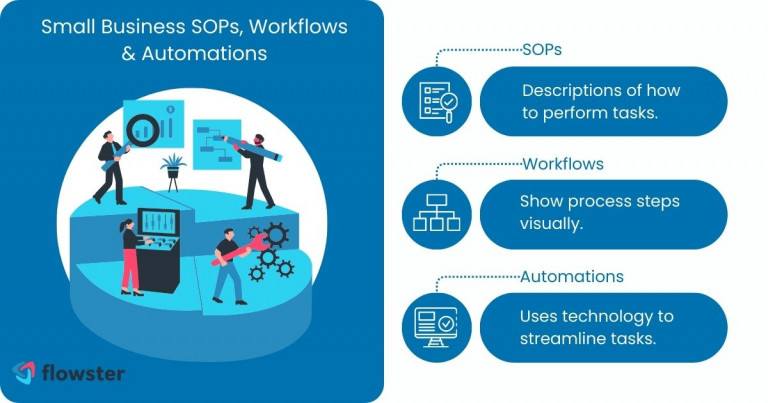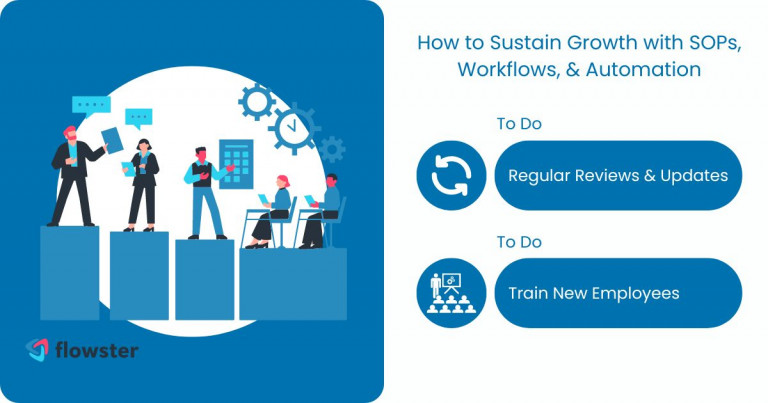Do you ever feel like your once-manageable small business is suddenly spiraling out of control? Sarah, a local bakery owner, knows the feeling all too well. What started as a passion project with a handful of loyal customers has blossomed into a thriving business. But with success came a new set of challenges. Sarah found herself juggling countless tasks—baking, managing inventory, taking orders, and handling social media—all while trying to keep up with the increasing demand. The once-joyful process of creating delicious pastries became a constant battle against time and inconsistency.
The good news is that there’s a solution: small business growth through scaling SOP workflows and SOP automation. Standard Operating Procedures (SOPs) are detailed instructions that outline the best way to complete specific tasks. Workflows provide a visual roadmap of the steps involved in a process. Automation utilizes technology to eliminate manual tasks or streamline processes.
This guide will equip you with the knowledge and strategies to leverage SOPs, workflows, and automation for sustainable small business growth, unlocking the path to consistency, efficiency, time savings, and a solid foundation for future success.
Article Outline
What are SOPs, Workflows, and Automation?
The secret weapon of successful small businesses lies not in magic but in well-defined systems. Here, we’ll delve into the power trio of SOPs (Standard Operating Procedures), workflows, and automation—the cornerstones of achieving small business growth through scaling SOP workflows and SOP automation.
SOPs (Standard Operating Procedures):
Imagine your business as a well-rehearsed orchestra. Every musician plays their part flawlessly, resulting in beautiful music. SOPs are like sheet music—detailed instructions outlining the exact steps for completing specific tasks within your business. This ensures consistency, reduces errors, and streamlines operations:
- Improved Consistency: SOPs guarantee that every task, from order processing to customer service interactions, is completed the same way every time, regardless of who’s doing it. This leads to a more predictable and reliable customer experience.
- Reduced Errors: Clear, step-by-step instructions minimize the chance of mistakes, especially when training new employees.
- Easier Training for New Employees: Onboarding new team members becomes a breeze with readily available SOPs for them to reference. They can quickly learn the ropes and become productive members of the team.
- Knowledge Preservation: SOPs capture institutional knowledge and best practices, ensuring valuable skills and expertise aren’t lost when employees leave the company.
Examples of SOPs in a Small Business:
- Order processing steps, including inventory checks, packaging, and shipment procedures.
- Guidelines for handling customer service interactions across different channels (phone, email, social media).
- A step-by-step process for creating and scheduling social media posts, ensuring consistent brand voice and messaging.
- An onboarding checklist for new employees includes outlining their initial tasks, introductions to key team members, and access to relevant resources.
Now, let’s visualize those SOPs in action.
Workflows:
Think of workflows as the visual representation of your business processes. These flowcharts or diagrams map out the steps involved in each SOP, making it easier to identify bottlenecks and optimize processes for maximum efficiency. Popular workflow management tools exist to help you create these visual roadmaps, fostering better communication and collaboration between teams.
Automation:
But what if you could eliminate repetitive tasks altogether? That’s the magic of automation. Automation tools are software programs that handle mundane tasks like sending email marketing campaigns, data entry, or scheduling social media posts. This frees up your valuable human resources to focus on more strategic initiatives that drive small business growth.
Examples of Automation in a Small Business:
- Setting up automated email workflows to nurture leads and engage customers.
- Utilizing data entry automation tools to eliminate manual data input and potential errors.
- Scheduling social media posts in advance using automation software to maintain consistent content flow.
- Sending automated appointment reminders to reduce no-shows and improve the customer experience.
By implementing these powerful tools—SOPs, workflows, and automation—you can unlock a new level of efficiency and consistency in your small business, paving the way for sustainable growth. However, implementing these systems isn’t always smooth sailing. In the next section, we’ll address some common challenges you might encounter and equip you with practical solutions to overcome them.

Common SOPs, Workflows, and Automation Challenges & Solutions
The path to small business growth through scaling SOP workflows and SOP automation isn’t without its hurdles. Let’s address some common challenges you might encounter and explore practical solutions to ensure a smooth implementation.
Resistance to Change:
Change, even positive change, can be met with resistance. Employees accustomed to a certain way of doing things might be hesitant to embrace new SOPs and workflows. Here’s how to overcome this hurdle:
- Involve Employees in the Creation Process: When employees feel a sense of ownership over SOPs and workflows, they’re more likely to adopt them readily. Involve them in the creation process, soliciting their insights and feedback.
- Highlight the Benefits for Them: Frame SOPs and workflows not as restrictions, but as tools to improve their work lives. Explain how they can lead to a reduced workload, less stress, and improved efficiency.
- Offer Training and Support: Provide comprehensive training during SOP and workflow implementation. Offer ongoing support to address any questions or concerns that may arise.
Lack of Time:
Creating detailed SOPs and workflows can seem like a daunting task, especially for busy small business owners. Here are some strategies to manage your time effectively:
- Start with the Most Critical Processes First: Identify the processes that cause the most bottlenecks, inconsistencies, or errors. Focus on creating SOPs and workflows for these high-impact areas first.
- Break Down SOPs into Smaller, Manageable Steps: Don’t try to tackle an entire SOP in one sitting. Break it down into smaller, more manageable steps. This makes the process less overwhelming and allows you to focus on one piece at a time.
- Utilize Free or Low-Cost Workflow Management Tools: There are many free or low-cost workflow management tools available online. These tools can streamline the process of creating and visualizing workflows, saving you valuable time.
Fear of Technology:
Some employees might fear that automation will replace their jobs. Here’s how to address this concern:
- Focus on Automating Repetitive Tasks, Not Core Competencies: Automation is meant to handle the mundane, repetitive tasks that drain time and energy. Focus on automating these tasks, not the core competencies and skills that make your employees valuable.
- Highlight How Automation Frees Up Employees for More Creative and Strategic Work: Explain how automation can actually empower your employees. By freeing them from repetitive tasks, they can focus on more creative and strategic work that contributes significantly to small business growth.
By acknowledging these challenges and implementing these solutions, you can pave the way for a smooth transition to SOPs, workflows, and automation within your small business. In the next section, we’ll delve into the practical steps involved in implementing these powerful tools.

Implementing SOPs, Workflows, and Automation
Now that you’re equipped to address common challenges, let’s dive into the practical steps of implementing SOPs, workflows, and automation to unlock small business growth.
Getting Started:
The first step is identifying areas for improvement. Look for tasks within your business that are prone to:
- High error rates: These tasks are prime candidates for standardization through SOPs.
- Inconsistencies: SOPs ensure everyone approaches the task in the same way, leading to more consistent outcomes.
- Time-consuming manual steps: These tasks are ripe for automation, freeing up your team to focus on higher-value activities.
Once you’ve identified these areas, prioritize the processes that will have the most significant impact on your business. Focus on tackling the ones that cause the biggest bottlenecks, inconsistencies, or eat up the most valuable time.
Creating SOPs:
Here’s a basic structure to use when creating your SOPs:
- Title: Clearly define the specific task the SOP outlines.
- Purpose: Briefly explain the purpose of the SOP and how it benefits the business.
- Required Resources: List any tools, software, or equipment needed to complete the task.
- Step-by-Step Instructions: Provide clear, concise, and actionable instructions for each step. Consider adding screenshots for visual learners.
- Troubleshooting Tips: Anticipate potential problems employees might encounter and offer solutions for overcoming them.
- Version Control: Implement a system for version control, keeping track of any updates or revisions made to the SOP. This ensures everyone is working with the most recent information.
Building Workflows:
Now, let’s visualize those SOPs in action. Choose a workflow management tool that suits your needs and budget. Many free or low-cost options are available online. Once you have your tool, use it to map out the steps involved in the chosen process. This will help identify any bottlenecks and opportunities for further optimization. If applicable, you can assign tasks to specific team members within the workflow and set deadlines to keep everyone on track.
Implementing Automation:
Automation is all about eliminating repetitive, rule-based tasks. Identify tasks in your workflow that meet these criteria—data entry, email marketing campaigns, or scheduling social media posts are excellent examples. Research automation tools that integrate seamlessly with your existing software. Start with simple automation tasks to ensure everything functions as expected. As you gain comfort and confidence, you can gradually expand into more complex automations.
Remember, the key to successful implementation is to start small and scale gradually. This allows you to identify and address any challenges along the way, ensuring a smooth transition to SOPs, workflows, and automation within your business. In the next section, we’ll discuss how to adapt and scale these systems as your business grows.
Flowster's AI-Driven Automation
Scaling Small Businesses with SOPs, Workflows, and Automation
As your small business thrives and experiences small business growth, your SOP workflows and automation systems need to adapt alongside it. Here’s how to ensure these systems continue to support your success:
Regular Review and Updates:
Don’t let your SOPs and workflows become outdated relics. Schedule regular reviews (quarterly or bi-annually) to ensure they accurately reflect current business practices. As your team grows, technology evolves, or your target audience shifts, adapt your SOPs accordingly. This keeps your systems relevant and ensures everyone is operating on the same page.
Training New Employees:
Onboarding new team members can be a breeze with well-defined SOPs and workflows in place. Use these systems as the foundation for your training program. New hires can quickly learn the ropes by referencing readily available SOPs, reducing the time and resources needed for training. This allows them to become productive members of your team faster, contributing to continued small business growth.
By incorporating these practices, you ensure your SOP workflows and automation systems remain dynamic and adaptable, scaling seamlessly alongside your growing business. In the next section, we’ll wrap up with a look at the key takeaways and the exciting possibilities that lie ahead.

Reap the Rewards: The Power of SOP Workflows and Automation for Sustainable Growth
The journey to small business growth requires a solid foundation. By implementing SOPs (Standard Operating Procedures), workflows, and automation, you equip your business with the tools and systems it needs to thrive. These systems ensure consistency, streamline operations, and free up valuable time and resources for strategic initiatives.
Remember, the key to success lies in taking action. Don’t let the idea of a complete overhaul intimidate you. Start small! Identify a critical process that plagues you with inconsistencies or inefficiencies, and create an SOP to standardize it. This initial step will demonstrate the transformative power of SOPs, workflows, and automation in your business.
Ready to take the first step towards scaling your business?
Flowster Marketplace offers a wealth of free resources to get you started, including SOPs and workflow templates that can be easily customized to fit your specific needs. And for those seeking a more hands-off approach, Flowster also provides “Done-for-You” services, where a team of experts can create and implement tailored SOPs and workflows for your business.
Embrace the power of systems and automation. Watch your small business soar with the efficiency and consistency that SOP workflows and automation provide, paving the way for sustainable small business growth for years to come.




